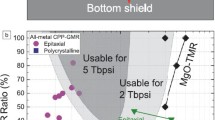Abstract
Due to the ever-increasing recording densities, disk-drive read channels are required to operate efficiently at high speeds. With the use of conventional design techniques, a compromise should be made between speed, power, latency and chip area. Improvements of head and media technology and the move from conventional single-track magnetic recording to two-dimensional magnetic recording help increase the areal density of magnetic data storage. Especially for the read channel, a performance gain is achieved by using more powerful coding and signal processing algorithms to mitigate inter-symbol and inter-track interferences. Timing recovery is essential to extract timing information in order to sample read data without a significant bit error, while calibration is performed to cancel the effects of gain and dc offset errors. Speed improvement and power consumption diminution are achieved in the resulting read channel system by using high-speed and power-efficient building blocks based on improved algorithms and pipeline stages to shorten critical paths.



















Similar content being viewed by others
Data availability
This declaration is not applicable.
References
Shimpuku, Y., Okazaki, Y., Ino, H., Yamamoto, K., & Suzuki, H. (2002). A high density and high data transfer rate flexible disk drive for insertion to the PCMCIA type-II slot. IEEE Transactions on Consumer Electronics, 48(2), 195–201.
Hori, Y., Kanai, Y., & Taima, K. (2010). An audiovisual content recorder using a removable hard disk drive. IEEE Transactions on Consumer Electronics, 56(4), 2324–2329.
Seong, Y. K., Choi, Y.-H., Park, J.-A., & Choi, T.-S. (2002). A hard disk drive embedded digital satellite receiver with scene change detector for video indexing. IEEE Transactions on Consumer Electronics, 48(3), 776–782.
Ryu, W., & Song, M. (2010). Design and implementation of a disk energy saving scheme for media players which use hybrid disks. IEEE Transactions on Consumer Electronics, 56(4), 2382–2386.
Thapar, H., & Patel, A. (1987). A class of partial response systems for increasing storage density in magnetic recording. IEEE Transactions on Magnetics, 23(5), 3666–3668.
Hong, J., Wood, R., & Chan, D. (1991). An experimental 180 Mb/sec PRML channel for magnetic recording. IEEE Transactions on Magnetics, 27(6), 4532–4537.
Ndjountche, T. (2018). Amplifiers, Comparators, Multipliers, Filters, and Oscillators. Boca Raton, FL, USA: CRC Press.
Proakis, J. G. (1991). Adaptive equalization for TDMA mobile channel. IEEE Transactions on Vehicular Technology, 40(2), 333–341.
Mueller, K. H., & Müller, M. (1976). Timing recovery in digital synchronous data receivers. IEEE Transactions on Communications, com–24(5), 516–531.
Zheng, N., Venkataraman, K. S., Kavcic, A., & Zhang, T. (2014). A study of multitrack joint 2-D signal detection performance and implementation cost for shingled magnetic recording. IEEE Transactions on Magnetics, 50(6), 1–6.
Ndjountche, T. (2016). Digital Electronics 2: Sequential and Arithmetic Logic Circuits. Hoboken, NJ, USA: ISTE-John Wiley.
Stas, F., & Bol, D. (March 2017). A 0.4V 0.08fJ/cycle retentive true-single-phase-clock 18T flip-flop in 28nm FDSOI CMOS, In Proc. of the IEEE ISCAS, Baltimore, MD, USA, pp. 2779–2782.
Mita, S., Izumita, M., Doi, Nobukazu, & Eto, Y. (1987). Automatic equalizer for digital magnetic recording systems. IEEE Transactions on Magnetics, 23(5), 3672–3674.
Yeh, W.-C., & Jen, C.-W. (2000). High-speed Booth encoded parallel multiplier design. IEEE Transactions on Very Large Scale Integration Systems, 49, 692–701.
Funding
This declaration is not applicable.
Author information
Authors and Affiliations
Contributions
This declaration is not applicable.
Corresponding author
Ethics declarations
Conflict of interest
This declaration is not applicable.
Rights and permissions
Springer Nature or its licensor (e.g. a society or other partner) holds exclusive rights to this article under a publishing agreement with the author(s) or other rightsholder(s); author self-archiving of the accepted manuscript version of this article is solely governed by the terms of such publishing agreement and applicable law.
About this article
Cite this article
Ndjountche, T. Hard-disk drive read-channel design trade-offs for areal densities beyond 2 Tb/in2. Analog Integr Circ Sig Process (2023). https://doi.org/10.1007/s10470-023-02198-0
Received:
Revised:
Accepted:
Published:
DOI: https://doi.org/10.1007/s10470-023-02198-0




